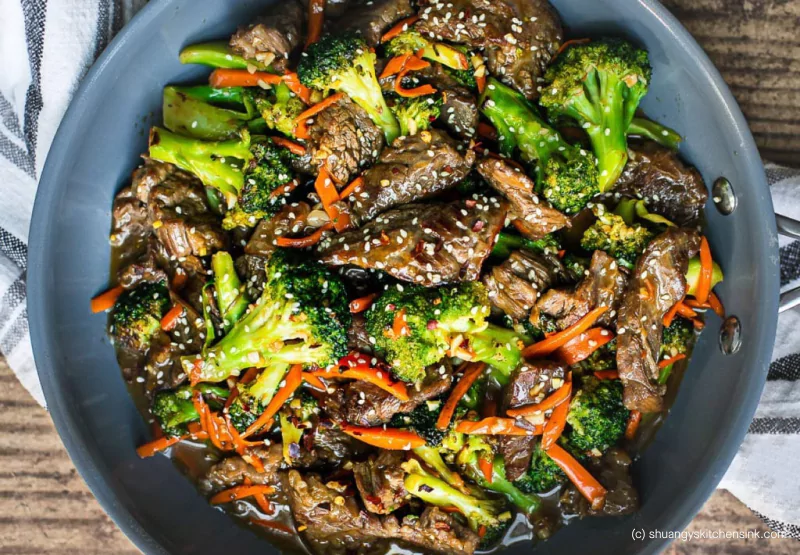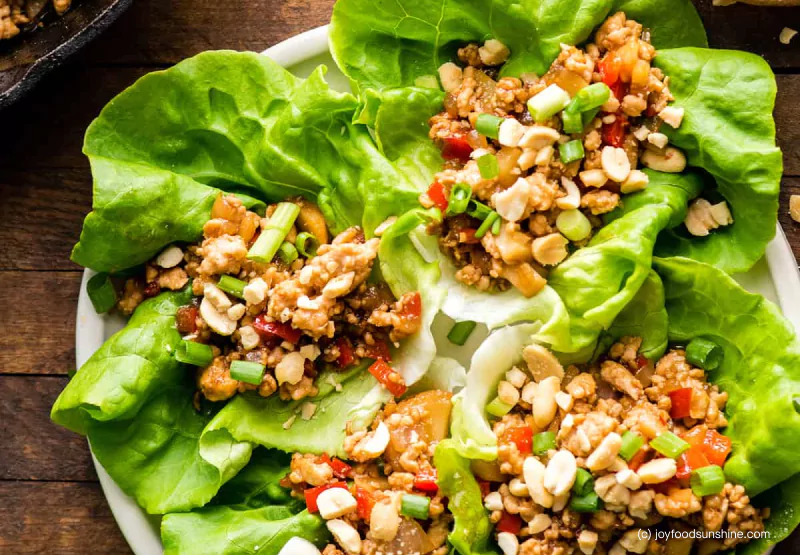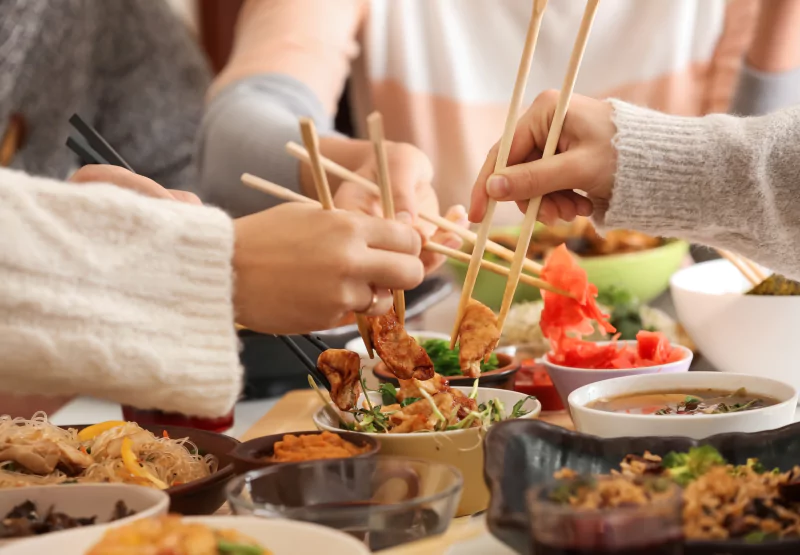7 Healthiest Chinese Food Dishes To Order

Key Takeways
If you love going to traditional Chinese or American-Chinese restaurants or ordering Chinese takeout, you may have wondered how to choose healthier options. While no cuisine is inherently unhealthy, there are certain cooking methods and ingredients that may be more nutritious than others.
There are eight unique regional cuisines in China and each one has their own unique flavors and dishes. Interestingly, much of what we consider “American-Chinese food” originates from Cantonese cuisine.
So, are the common appetizers and entrees found in typical Chinese restaurants healthy? In this article, we’ll discuss some typical Chinese food ingredients and some tips for ordering healthy Chinese food or making it at home.
Typical Chinese Food Ingredients
When you think of Chinese dishes, fried rice, chop suey, steamed dumplings, hot and sour soup, and lots of vegetables may come to mind. Like with any cuisine, some dishes may be more nutritious than others, and it’s important to know which types of ingredients may be healthier choices than others.
Some of the common ingredients in traditional Chinese and American-Chinese cuisine that give it a distinct flavor include things like soy sauce, rice vinegar, sesame oil, chili oil, Sichuan pepper, and MSG.

Many Chinese dishes also include lots of fiber-rich vegetables and protein sources such as tofu, poultry, beef, and fish. Carbohydrates like white rice and brown rice, noodles, and other starches. Here are some sources of these nutrients in Chinese food:
Common Vegetables in Chinese Food Include:
- Bok choy
- Chinese broccoli
- Chinese water spinach
- Napa cabbage
- Savoy cabbage
- Bamboo shoots
- Leeks
- Lemongrass
- Chili peppers
- Ginger
Common Protein Sources Include:
- Tofu
- Poultry, including chicken and duck
- Beef and pork
- Mung beans
- Seitan
- Seafood, including fish and shrimp
Common Carbohydrate Sources Include:
- Rice
- Chinese pearl barley
- Rice flour
- Tapioca, potato, wheat, and corn starches
- Egg noodles
- Lo mein noodles
- Rice noodles
- Glass noodles
- Wonton wrappers
- Dumpling skins
- Egg roll and spring roll wrappers
7 Healthier Chinese Food Options
When eating out, a good rule of thumb is to focus on foods high in protein and fiber. Avoiding or limiting fried food and opting for steamed foods instead can also be beneficial.
Here are some healthier dishes and menu items that are common in Chinese or Chinese-American restaurants. Because meals cooked at home tend to be even healthier than restaurant meals, we’ve included some recipes so you can try making these dishes at home.
1) Beef with Broccoli

Because of its protein and fiber content, beef with broccoli can be a healthier choice. Broccoli contains about 2.4 grams of fiber per cup. It’s also a great source of essential vitamins and minerals, including calcium, potassium, vitamin C, Vitamin A, folate, and vitamin K.
Beef is a good source of vitamin B12, protein, and iron. However, moderation is key when it comes to red meat. The World Cancer Research Fund suggests consuming no more than three servings of red meat per week.
Beef with broccoli is also a good low carb option for anyone limiting their intake of carbohydrates in their diet or following a ketogenic diet.
Make it at Home: Beef and Broccoli Stir Fry
Here’s a healthy beef with broccoli recipe to try out at home from Shuangy’s Kitchen Sink. For a glucose-friendly take, you might want to opt for smaller amounts of brown rice instead of white.
Ingredients
- 1.2-1.5 pound beef flank steak
- ¼ cup cooking oil
- ½ head of broccoli
- 1 carrot, sliced
- 1 clove of garlic, minced
- 2-3 tablespoons coconut aminos
- 1 tablespoon arrowroot flour
- Pinch of salt
For the stir fry sauce:
- ¼ cup coconut aminos
- ¼ cup water or beef stock
- 1 tablespoon rice vinegar
- 1 heaping tablespoon arrowroot flour
- 2 teaspoons sesame oil
2) Chicken Lettuce Wraps

Another great low-carb option is lettuce wraps. Lettuce contains bioactive compounds with anti-inflammatory, anti-diabetic, and cholesterol-lowering properties, and is also a source of fiber, vitamin C, and folate.
Chicken is an excellent source of lean protein and many B vitamins. Paired together, this high-protein and fiber meal is a great option for regulating blood sugar levels.
Make it at Home: Chicken Lettuce Wraps
Try out this Chinese chicken lettuce wrap recipe from JoyFoodSunshine for your next low-carb lunch or dinner.
Ingredients
- 1 pound ground chicken
- 1 tablespoon peanut oil
- ½ onion, minced
- 1 cup green or red pepper, dices
- 1 8-ounce can water chestnuts, drained and minced
- 3 tablespoons soy sauce
- 3 tablespoons hoisin sauce
- 1 tablespoon sesame oil
- 1 tablespoon rice vinegar
- 1 tablespoon peanut butter
- 1 tablespoon honey
- 2 teaspoons chili sauce
- ½ teaspoon garlic powder
- ¼ teaspoon powdered ginger
- ¼ cup peanuts, crushed
- Lettuce, or your favorite Asian salad mix
3) Glass Noodles
Glass noodles, also called cellophane or starch noodles, are long, transparent noodles made from starch. They are gluten-free and often made with potato, sweet potato, tapioca, or mung bean starch.
Starchy glass noodles are best eaten with protein-rich options alongside to help minimize blood sugar spikes.
Make it at Home: Starch Noodles Stir Fry
Here’s a healthy stir fry glass noodle recipe from China Sichuan Food to try out.

Ingredients
- Half of a cabbage, shredded
- 1 small bunch of glass noodles
- 1 green onion
- 2 cloves garlic
- 2 slices of ginger
- 2 dried chili peppers
- 10 whole Sichuan peppercorns
- 1 tablespoon cooking oil
- 1½ tablespoons light soy sauce
- 1 teaspoon dark soy sauce. optional
- Pinch of salt
Pro tip: include some protein such as tofu, seafood, or chicken alongside to help keep blood sugar balanced and improve satiety!
4) Steamed Vegetables
Steaming is one of the main cooking methods in Chinese cuisine. It involves suspending food over boiling or simmering water, and using the resulting steam to cook the food.
Because steaming requires little to no oil, ordering steamed vegetables instead of fried can help you limit extra oil and calories. Vegetables are also some of the best sources of fiber, vitamins, and minerals.
Make it at Home: Ginger-Sesame Steamed Vegetable Salad

For an easy homemade steamed vegetable dish, try this one from Taste of Home.
Ingredients
- 2 tablespoons fresh ginger root
- 2 tablespoons sesame oil
- 1 tablespoon fish sauce
- 1 teaspoon sugar
- ½ teaspoon soy sauce
- ¼ teaspoon salt
- 1 cup fresh green beans or snow peas
- 4 cups fresh broccoli florets
- 2 large carrots, julienned
- 9 ounces fresh spinach
- ½ cup finely chopped unsalted dry roasted peanuts
- coarsely chopped fresh cilantro and julienned fresh ginger
Pro tip: Boost the nutritional value of this dish with some added protein!
5) Chicken and Mushroom Soup
Chicken and mushroom soup can be a healthy and nutrient-rich choice in Chinese restaurants. Aside from chicken’s high-protein content, the mushrooms in the soup will be rich in minerals and vitamins.
Mushrooms are also full of antioxidants, which can protect your cells from damage-causing free radicals, and beta-glucans. Polysaccharides found in mushrooms that have been shown to have anticarcinogenic effects, stimulate the immune system, and may have a positive effect on blood sugar.
Mushrooms are also one of the few foods that contain vitamin D, a necessary vitamin that is important for many bodily functions.
Make it at Home: Chicken Soup with Ginger and Shiitake Mushrooms
To make a hearty and comforting Chinese Chicken soup at home, try this recipe from Simply Recipes. To make it more blood sugar friendly, you may choose to omit the added sugar.
Ingredients
- 1 ounce dried shiitake mushrooms, preferably dried
- 3 cups boiling water
- 1-1½ pound chicken thighs, preferably bone-in
- 1 1-inch piece fresh ginger, peeled and thinly sliced
- 2 tablespoons soy sauce
- 2 teaspoons sugar (may omit)
- A pinch of kosher salt
- 1 teaspoon cornstarch
6) Steamed Shrimp
Shrimp is a source of omega-3 fatty acids. Omega-3s help your heart, blood vessels, lungs, immune system, and endocrine system function. They also form the structure of your cell membranes and provide energy for the body.
Make it at Home: Chinese Steamed Shrimp
Ordering steamed shrimp instead of fried can also help you limit extra oil and calories. Try this simple and tasty recipe from A Dash of Soy.
Ingredients
- 1 pound fresh shrimp
- 2 Thai chilis
- 2 tablespoons soy sauce
- 1 tablespoon vegetable oil*
Pro tip: For healthy oil options you might want to swap in place of the vegetable oil, check out our article on cooking oils.
7) Mapo Tofu

Mapo tofu is a traditional Sichuan dish, and typically consists of tofu in a spicy sauce. Tofu is a great source of plant-based protein, and is a good source of iron, calcium, potassium, and unsaturated fats.
Mapo tofu also typically contains Sichuan pepper, which contains bioactive compounds that may have neuroprotective effects. The chilis that give the dish its spice contain capsaicin, which contains antioxidants that may have anti-inflammatory and pain relief effects.
Capsaicin can also have positive effects on many chronic health conditions like arthritis and diabetic neuropathy. It may also be beneficial for weight management.
Make it at Home: Mapo Tofu
Here’s a great recipe to experiment with from Red House Spice!
Ingredients
- 600 grams soft or medium firm tofu
- 1 teaspoon salt
- 2 tablespoons neutral cooking oil
- 100 grams minced beef or pork
- 1 teaspoon minced ginger
- 2 tablespoons Sichuan chili bean paste
- 1 tablespoon fermented black beans, rinsed and chopped
- 1 tablespoon ground chili or chili flakes
- 1 tablespoon minced garlic
- 1 tablespoon Shaoxing rice wine
- 400 milliliters water or unsalted stock
- 2 tablespoons cornstarch, mixed with 3 tablespoons water
- ½ teaspoon ground Sichuan pepper
- 1 stalk scallions, finely chopped
Helpful Tips when Ordering Chinese Food
Here are some quick tips to keep in mind when ordering Chinese food. Remember that these tips can also apply to any meal you opt for when eating at restaurants.
Get your Sauce on the Side

Restaurant condiments and dipping sauces can be high in sugar or sodium. Ordering your sauce on the side allows you to control your portion. You may also want to avoid any sugary sauces and opt for a light sauce with minimal ingredients when possible.
Limit Fried Foods
A diet high in fried foods can increase your risk for cardiovascular disease, diabetes, hypertension, and obesity. This is partly because of their trans fat content, which can raise bad cholesterol levels and reduce good cholesterol in your body.
While many fast food options may be fried, opting for a steamed or baked variety may be a healthier alternative.
Stock up on Veggies and Protein
Vegetables are excellent sources of fiber, vitamins, minerals, and other nutrients. A diet high in fruits, vegetables, and fiber has been linked to a lower risk of certain cancers.
Vegetables are a particularly good option if you are trying to avoid blood sugar spikes. This is because the fiber in the veggies helps slow the absorption of sugar into your bloodstream.
Protein, especially paired along with fiber-rich veggies, can be an excellent nutrient-dense choice to keep you satisfied and nourished while supporting blood sugar balance.
Be Conscious of Calories

As with all foods, some dishes can be higher in calories than others. Keep this in mind when ordering, and make sure to take notice of portion sizes. Looking at a menu online before going to the restaurant can help you plan ahead.
You may consider consulting a registered dietitian if you’re unsure of the correct caloric intake for you and your wellness goals.
Find the right Nutrisense programto turn insight into progress.
Go Beyond Glucose Data with Nutrisense
Your glucose can significantly impact how your body feels and functions. That’s why stable levels are an important factor in supporting overall wellbeing. But viewing glucose isn't enough. Nutrisense, you’ll be able to learn how to use your body's data to make informed lifestyle choices that support healthy living.
One-to-one coaching
Sign up to access insurance-covered video calls to work with a glucose expert: a personal registered dietitian or certified nutritionist who will help tailor your lifestyle and diet to your goals.
Monitor and measure what matters
With the Nutrisense CGM Program, you can monitor your glucose with health tech like glucose biosensors and continuous glucose monitor (CGM)s, and analyze the trends over time with the Nutrisense App. This will help you make the most informed choices about the foods you consume and their impact on your health.
Find your best fit
Ready to take the first step? Start with our quiz to find the right Nutrisense program to help you take control.

Heather is a Registered and Licensed Dietitian Nutritionist (RDN, LDN), subject matter expert, and technical writer, with a master's degree in nutrition science from Bastyr University. She has a specialty in neuroendocrinology and has been working in the field of nutrition—including nutrition research, education, medical writing, and clinical integrative and functional nutrition—for over 15 years.




